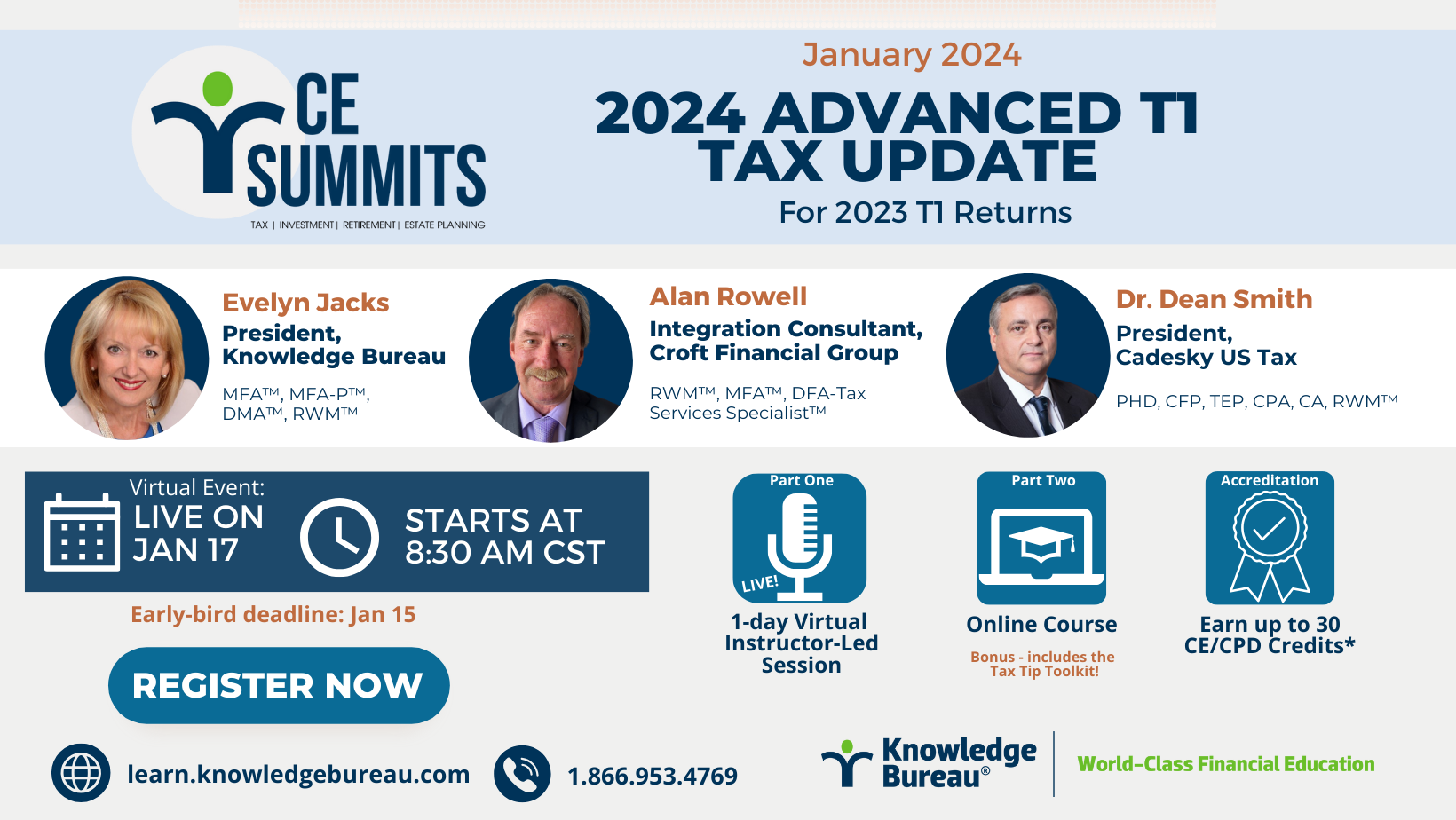Last updated: December 13 2023
Canada Dental Care Plan Includes Some Seniors, Affects T4 and T4As in 2023

Evelyn Jacks and Vince Crosby
On December 11, the federal government announced it will introduce the new Canada Dental Care Plan (CDCP) to seniors age 87 and above in December 2023. Access for others will begin over the 6 months ending in June 2024. In all cases, eligible claimants must not have access to a private dental care plan, and 2022 tax returns must have been filed to meet income testing. Tax specialists should contact our oldest seniors immediately to discuss eligibility and in addition, be mindful of changes to T4 and T4A slip reporting as well. Here are the details:
The Existing Canada Dental Benefit. The new plan is not the same as the current interim plan, which is important. Eligibility for children 12 and under continues under the Canada Dental Benefit for families with net income under $90,000. A tax-free payment of $260, $390, or $650 is available for each eligible child, depending on income level. A maximum of 2 payments per child can be applied for until June 30, 2024 for dental care received between July 1, 2023 and June 30, 2024 and one additional payment if certain criteria is met. 
The New Canada Dental Care Plan. Applications for the new CDCP will first open as follows:
- for seniors aged 87 and above in December 2023,
- for those aged 77 to 86 in January 2024,
- for those aged 72 to 76 in February 2024, then
- those aged 70 to 71 years in March 2024.
Note: These taxfilers will receive letters inviting them to apply with a personalized application code and instructions on how to apply through Service Canada. They will also be able to apply by telephone. Many, if not most, of these older seniors will need help with this process. The letter will be sent to people who are:
- are 70 years old, or will be 70 years old or older by March 31, 2024;
- have an adjusted family net income less than $90,000 based on their and/or their spouse’s or common-law partner’s 2022 tax returns; and
- were a resident of Canada in 2022 for tax purposes.
Later in the year, younger Canadians will be invited to apply:
- for seniors age 65 and older an online portal will be available in May 2024 to apply for the CDCP.
- for those with a valid Disability Tax Credit certificate can apply online in June 2024
- children under the age of 18 can also apply online as of June 2024.
- All remaining eligible Canadian residents (ages 19-64) will be able to apply online in 2025.
The government also notes that from December 2023 until end of April 2024, seniors who receive invitation letters may call Service Canada to apply via an automated Interactive Voice Response (IVR) system. At hand must be two pieces of identification. They will be required to say whether they have access to any type of dental benefits. The applicant will immediately be notified whether they have been successful in applying and are eligible. They will also receive a letter confirming this information.
This is a red flag for an audit alert. If it is later found that they do have access to a dental care plan, as per T4 and T4A reporting explained below, the money will need to be repaid.
Sun Life is the provider. Once an individual is determined to be eligible, Service Canada will share the applicant’s information with Sun Life, who will enrol eligible applicants in the CDCP and will send them a welcome package, including information on the CDCP, coverage details, their member card, and the start date of their coverage.
Benefits should be provided as early as May 2024, starting with seniors and according to their various eligibility start dates. This means that appointments with oral health care providers should not start before these coverage start dates. The CDCP will not reimburse oral health care services received before the start date provided in the welcome package from Sun Life.
What is covered? Services covered, on recommendation of the health care provider include the following, with some services only becoming available in fall 2024, according to the CRA:
- preventive services, including scaling (cleaning), polishing, sealants, and fluoride;
- diagnostic services, including examinations and x-rays;
- restorative services, including fillings;
- endodontic services, including root canal treatments;
- prosthodontic services, including complete and partial removable dentures;
- periodontal services, including deep scaling;
- oral surgery services, including extractions.
Consultations between the federal and provincial/territorial governments are on-going to co-ordinate various publicly funded programs.
Co-payments – exactly how much will be paid? Only a percentage of eligible expenses will be paid at the established CDCP fee rates. The government has provided a definition of a “co-payment” - the percentage of CDCP fees not covered which will have to pay directly to the oral health provider. This will depend on the adjusted family net income as follows:
- no co-payment for those with an adjusted annual family net income under $70,000;
- a 40% co-payment for those with an adjusted annual family net income between $70,000 and $79,999;
- a 60% co-payment for those with an adjusted annual family net income between $80,000 and $89,999.
This is where things become somewhat merky from a privacy and info sharing point of view. It is unclear how this information is going to be shared with oral health providers, who will also be encouraged to follow the CDCP established fees. The federal government points out these are not the same as the provincial and territorial fee guides.
In early 2024, these oral health providers licensed and in good standing in their province or territory, including dentists, denturists, dental hygienists and dental specialists, will be able to enrol, on a voluntary basis, directly with Sun Life.
Employers Beware – new T4 Reporting. On November 16th the Government of Canada announced there will be changes with the reporting of T4 slips for employers in Canada. With the introduction of the new Canadian Dental Care Plan for uninsured Canadians with adjusted family net incomes under $90,000, this reporting will be required to ensure only eligible Canadian are applying to this program. Employers who fail to be compliant and report the required information may result in financial penalties.
What needs to be reported? Employers will be required to report if an employee’s had access to dental insurance or dental benefits of any kind during the 2023 tax year and future tax years. Employers will need to identify who the coverage was available to and complete box 45 with the appropriate code description. The Code Access (descriptions) options are:
- Not eligible to access any dental care insurance, or coverage of dental services of any kind.
- Payee only.
- Payee, spouse, and dependent children.
- Payee and their spouse.
- Payee and their dependent children.
https://www.canada.ca/en/revenue-agency/services/tax/businesses/topics/payroll/completing-filing-information-returns/t4-information-employers/t4-slip.html?utm_campaign=not-applicable&utm_medium=vanity-url&utm_source=canada-ca_t4-information-employers
CRA will not require box 45 to be completed for electronically filed T4 Slips before January 2024. The CRA, to reduce the burden on employers, will allow the omission of box 45 only if the applicable code is 1 for the 2023 tax year.
What is a taxable benefit? The CRA defines a taxable benefit as a benefit paid or given directly to an employee that has an economic advantage. An example of a dental benefit would be:
- Johnny is 68 years old and works as a greeter at his local grocery store to earn extra income to assist with his retirement. The employer does not have group benefits for their employees or offer health spending accounts. In mid-June the employer noticed that Johnny was having issues with his teeth and was starting to miss work due to pain he was experiencing. Johnny being a good employee and the employer wanting to help paid for Johnny to receive the dental care needed to take care of the pain. The employer will include the cost of the dental care as a taxable benefit and now be required to also report this on Johnny’s T4.
Potential downfalls to this type of information collecting are that it does not distinguish between periods when employees may or may not have been employed by the employer. For example:
- Sam a single father of two lost his employment at the factory he worked at in February where he had benefits. After being unemployed for four months began working for a seasonal landscaping company. His new employer does not offer benefits and will be laying Sam off once the seasons change, and the snow begins to fall. One of Sam’s children needs some dental care in November and Sam applies for government assistance. Sam may find himself having to prove his claim since the CRA will have on file a T4 for the tax year showing dental benefits.
You provide small business with services that include preparing and reporting T4 slips, it may be in the best interest of you and your clients to being implementing a process to have this information ready before the busy T-slip season begins
